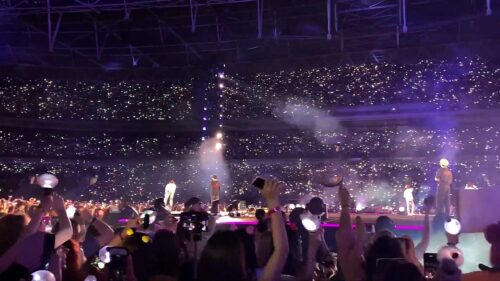
In the realm of entertainment, the boundaries separating sports and music are becoming increasingly indistinct. What were once arenas solely dedicated to sporting events are now emerging as favoured locations for hosting musical concerts. From Madison Square Garden in New York to Wembley in the UK, these iconic venues are hosting as many gigs as they do sporting events. If you prefer the latter, consider spicing up your experience by placing a bet in the safe environment of the 1xbet app, which has a review at the link. But what makes the sports stadiums the most popular venues for music concerts? Let’s dive into the melody of this trend.
The Grand Stage: Sports Stadiums as Musical Arenas
Madison Square Garden: The Unrivaled Legend
Securing the premier position among U.S. concert locations, Madison Square Garden stands as an unparalleled icon. Accommodating more than 20,000 spectators, this famed venue has been the stage for numerous memorable performances, establishing itself as a magnet for global music enthusiasts. The sheer magnitude, cutting-edge technology, and electric atmosphere make it the ultimate destination for artists and fans alike.
Wembley Stadium: A New Home for Music
In the year 2023, Wembley, recognized as the most expansive stadium in the UK, served as the venue for an equal number of musical gigs and football games. With a total of 16 concerts that sold out in 2022, featuring renowned artists such as Coldplay and Ed Sheeran, and a staggering 1.3 million tickets sold, Wembley has emerged as a representation of the escalating appetite for concerts held in stadium settings. The scale and capacity to hold 60,000 people have attracted artists like Beyoncé and Pink, making it a prime choice for big tours in the UK.
The Staples Center: A Symbol of Grandeur
Serving as the base for several professional sports franchises, The Staples Center in Los Angeles is renowned for its unmatched production excellence and vibrant ambiance. With the ability to accommodate more than 20,000 spectators, this versatile venue enhances the vigor of every live show, drawing elite performers and music lovers from all corners of the world.
The Allure of Stadium Concerts: Why Artists Choose the Big Field
Bigger Venues, Bigger Profits
The cost of putting on worldwide tours is enormous. Artists need to sell out bigger venues to make it pay. Stadiums like the Stadium of Light in Sunderland, with a capacity of 60,000, offer the scale that artists need. The space, city-center location, and ability to host large numbers of trucks for staging and production make stadiums attractive to concert promoters.
Freedom and Flexibility
Stadiums allow more freedom for artists’ production teams. The positioning of sound systems can be tailored to each venue’s particular acoustics. The unique open-air design of venues like The Gorge Amphitheatre in Washington, with a capacity of 20,000, allows concertgoers to revel in nature while enjoying performances, creating a unique and immersive experience.
The Nostalgia Factor: Fenway Park
Imagine rocking out to your favorite band in the same venue that has seen countless iconic baseball moments. Fenway Park in Boston offers a one-of-a-kind concert experience, combining the excitement of live music with the nostalgia of America’s favorite pastime.
Challenges and Risks: The Big Gamble of Stadium Concerts
The Pressure of Scale
With bigger tours comes bigger risks. Wembley’s stadium director, Liam Boylan, notes that everything’s bigger in stadium concerts: more trucks, more crew, more equipment. It’s a big gamble for promoters, who must weigh whether the interest in a particular artist is high enough to fill the seats. If a show doesn’t sell, they’re liable, adding a layer of pressure to the grandeur of stadium concerts.
Timing and Coordination
Stadium tours present a unique challenge of fitting concerts into the calendar without interfering with the venues’ main business: sport. Clashes with major sporting events, like the FA Cup at Wembley, create a complex jigsaw puzzle for managers and agents. The solution? Increasing the number of concerts that can take place per year, accommodating more touring artists.
Impact on Local Economies: A Boost in Trade
Pricing Concerns
While stadium concerts provide a massive boost in trade around cities like Sunderland, there are genuine concerns about promoter pricing. With general admission ticket prices often over £100, compared to match-day tickets at £29, promoters must be mindful of the local economy and disposable income.
Energy Costs and Consumer Impact
Increased energy costs have affected venues like Wembley Stadium, leading to a rise in the price of renting the venue. While venue operators must cover costs, they also strive to avoid outpricing fans, maintaining a balance between economic realities and audience accessibility.
Future Trends: The Unstoppable Rise of Stadium Concerts
The Demand Continues
Stadium tours show no signs of stopping. The demand for bands like Arctic Monkeys is huge, with 500,000 tickets sold in England and Wales alone for their summer stadium tour in 2023. The trend of choosing stadiums over arenas continues to grow, with artists seeking the best possible experience for fans in each venue.
A New Era of Entertainment
From Red Rocks Amphitheatre in Colorado to Barclay’s Center in New York, the United States is home to some of the most iconic and spectacular concert venues. The trend is global, with stadiums becoming the number one choice for big tours in the UK and beyond. The blend of historic significance, modern marvels in design, and the sheer scale of venues is defining a new era of entertainment.
Conclusion: The Symphony Continues
The most popular sports stadiums for music concerts are not just venues; they are experiences. These venues present a harmonious mixture of reminiscence, magnificence, and creativity that strikes a chord with performers and audiences alike. As the spheres of sports and music further merge, the melodious composition of stadium concerts will persist, etching indelible impressions and laying the groundwork for the forthcoming evolution of live musical performances.





![[Music] Willy Rock Ft Settings - Adaugo](https://blogger.googleusercontent.com/img/b/R29vZ2xl/AVvXsEgyrzmvOXQB_A62ild7FM1Oi9qObVAZdMQ-capoGV8KrvK1MLDQ8qtTzgncSEeu7BBoPxkTJwNLlh3yJcfiyjQR8glJzF2M_gOi30Xx3lm6VytGQ6k18tWp5I4plcZAuphVsXlDKH-J1WdZ1X6ogo8tmFOL8NeHnW7wly9TtR_ZvAzbGCJ_81GJlQ/w72-h72-p-k-no-nu/IMG-20250313-WA0076.jpg)

0 Comments